|
Supermarine Spitfire Vb
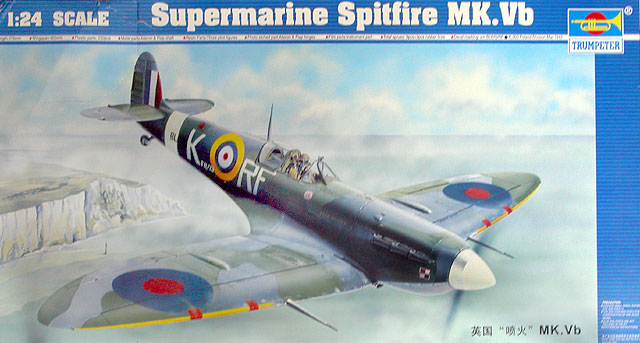
Trumpeter
S
u m m a r y
|
| Catalogue Number: |
02403 |
| Scale: |
1/24 |
| Contents and Media: |
233 parts in light grey and clear
injection molded plastic; metal shafts for ailerons and flaps; rubber tyres; photo-etched parts for control surface hinges; three resin pilot
figures; markings for one
aircraft |
| Price: |
USD$107.97
from Squadron.com |
| Review Type: |
FirstLook |
| Advantages: |
Accurate overall outline compared to
respected drawings; constant and crisply engraved panel line; good quality moldings; workable control surfaces;
gull wing represented; nicely detailed
engine and cockpit parts; very thin, clear and accurate transparent parts;
three resin
pilot figures included. |
| Disadvantages: |
Seat appears to be based on a museum
example with wooden seat base; incorrect fabric texture on upper surfaces
of horizontal stabs; some detail issues (see text for details); inaccurate
decals and painting callouts. |
| Recommendation: |
Recommended. |
Reviewed
by
Brett Green

Trumpeter's 1/24 scale Spitfire Vb
is available online from Squadron.com
Trumpeter's new 1/24 scale Spitfire Mk.Vb comprises 233 injection molded parts in grey plastic and clear styrene (including clear
side engine covers), rubber
tyres, a small bag of metal rods, a photo-etched fret with hinges for control
surfaces and an acetate sheet with printed instruments and three resin pilot
figures.
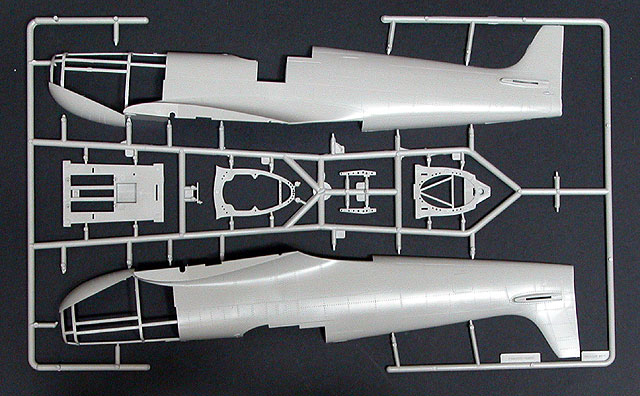
Click the thumbnails below to view
larger images:
The parts are perfectly moulded with crisply engraved panel
lines. Recessed rivets are also cover the airframe, but these are very restrained and, in
this large scale, should look good under a coat of paint. Ejector pin marks are,
for the most place, not placed in visible locations except for a few on cockpit
bulkheads. The plastic is quite soft and pleasant to work with.
There are plenty of sprue connectors on the big wings and
fuselage (as you might expect) but they mostly connect to the joining surfaces
of the parts. This significantly reduces the risk of scarring the visible
surfaces of the parts.
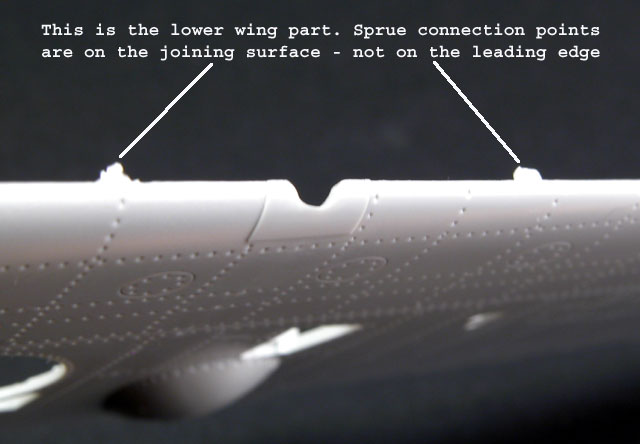
Fabric surface detail on the rudder and elevators is
exaggerated. A few minutes sanding should fix this problem. Oddly, the top of
each horizontal stabiliser has a heavily scalloped surface. It looks like an
overscale representation of the wing of a WWI biplane. Even more oddly, the
lower surface of the stabs feature the nice, metal riveted texture present
elsewhere on the aircraft. Fortunately, just a few more minutes sanding will
address this issue.
The clear parts are remarkably thin and flexible.
All control surfaces, including the flaps, are workable due to
the inclusion of hinges made from etched metal and steel rod. The undercarriage
gear is sprung too.
Cockpit and engine detail is quite good. The engine includes
flexible leads. The cockpit, however, will benefit from additional work.
Specifically, the seat seems to be copied from a museum specimen with a
non-standard item with a wooden base and a strange oval-shaped backrest.
Detail extends into the wing, where the gun access panels may be
left open to display the Hispano 20mm cannon and .303 Browning machine guns. The
mid section of the full-span lower wing also features structural detail that
will be visible through the partial floor.
Other nice touches include a positionable flap indicator panel,
positionable radiator flap (with support struts), optional position landing
lights and a bomb with centreline rack as a further option.
The decals are nicely printed and the lower wing roundels even
have a cutout for the shell ejector port. However, the red is too bright and the
codes and fuselage band are supplied in white, not Sky as they should be.
Furthermore, paint callouts in the instructions are not accurate. They suggest "Dark
Egg Blue" for the interior (should be RAF Interior Green); with Olive Drab
and Dark Sea Grey for the upper surfaces (should be Dark Green and Ocean Grey);
and IJN Grey for the lower surfaces (should be Medium Sea Grey). The callout for
the Insignia Yellow leading edge wing strip is Middle Stone. The spelling of the
aircraft name as "EVER REAUY N" is a little bewildering too. Stencil spelling is
fine though.
Three resin figures are included with the kit. All are standing
in casual, if somewhat stiff, poses. They are beautifully cast and the detail is
excellent.
Test Fitting
I have test-fitted the fuselage and wing parts.
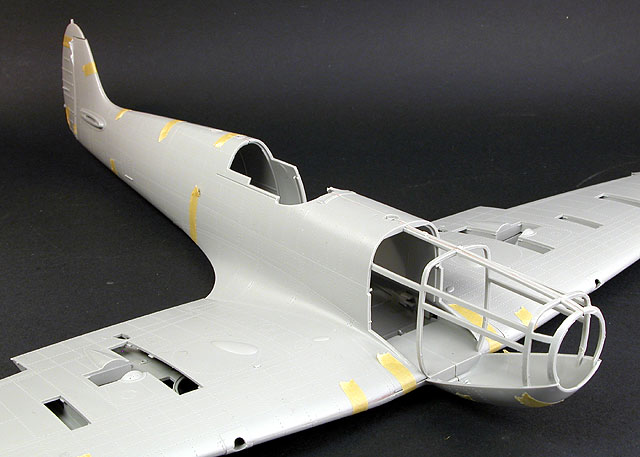
The fuselage wing roots press into a locating slot on the
corresponding joining surface of the upper wing halves. This guarantees a
gap-free fit at the wing root, even without adhesive. The dihedral, as set by
the full-span lower wing, looks good too.
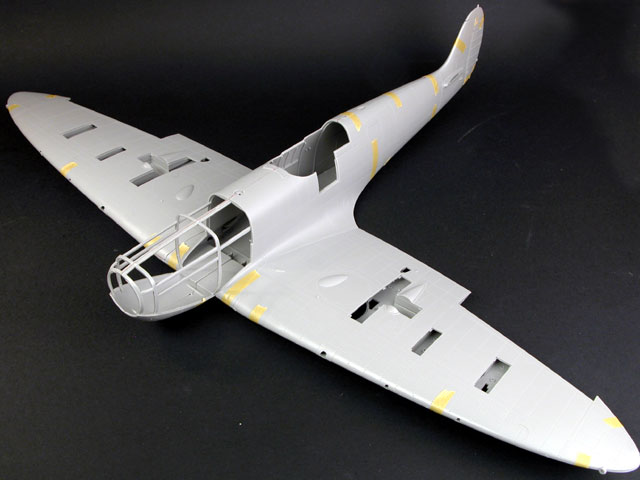
Fit of the major parts is gap free so far. This is very
encouraging for the remainder of construction.
Accuracy
The model is representative of an early Spitfire Mk.Vb, as
suggested by the external armoured glass and the De Havilland propeller
assembly.
I compiled several scale drawings, including the well-regarded
1994 plans by A.R. Clint that appear in "Spitfire the Canadians" by Robert
Bracken. I also used plans from the Japanese "Model Art Special No. 387 -
Supermarine Spitfire". These plans broadly corresponded, but varied in certain
details.
The Clint plans were scaled against the length of the kit
fuselage from the rudder hinge line to the front of the fuselage. This would
clearly indicate the proportions of the model against the plans. The starboard
upper wing half was also subjected to this treatment.
The fuselage comparison against the Clint plans is shown
below:
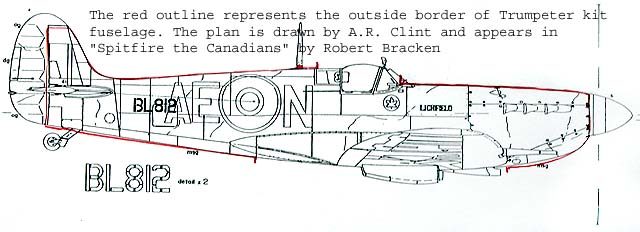
As can be seen, the kit conforms very closely to the
Clint plans. The biggest discrepancy is the height of the rear fuselage /
empennage, which is around 1 millimetre taller on the plastic than it is on
the plan. A picture of the plastic overlaid on the same plan is seen here:
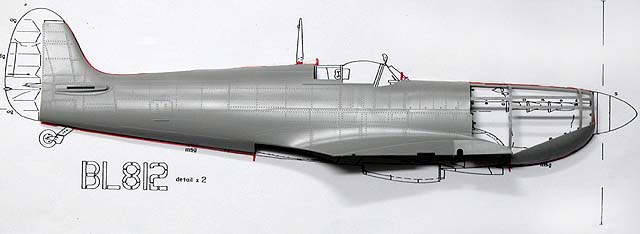
The results of the wing comparison may be seen here:

The semi-elliptical Spitfire wing is very tricky to capture in
plastic. Trumpeter has done a good job here too.
The kit was also compared against the Model Art drawings. These
drawings were increased from their original 1/48 scale to 1/24 scale:

The detail differences between the drawings can be seen here.
However, the overall conformance is, once again, very close.
Tweaks
Plans do not always tell the entire story. Subtle contours on
the airframe cannot be easily conveyed in two dimensions.
The three-dimensional shape also looks very good indeed,
including depiction of the gull wing at the trailing wing to fuselage join.
However, there are a few contours on the kit that should be noted:
-
The top of the rear fuselage is
fractionally too oval-shaped. Behind the cockpit, the section shape of the upper
fuselage should be shaped a bit like an egg with flattened sides. It should be
noted, though, that this will be quite hard to pick unless you are really
looking for it. If you are worried about this, a few minutes sanding the top
sides of the fuselage should improve the profile.
-
There is a slight curve that drops
from the top of the front engine cowl to the spinner. The profile of the top
cowl should be pretty much flat. Once again, sanding will address this issue.
-
The characteristic bulge on each side
of the top engine cowl is not present. This is another aspect that will only be
obvious if you are looking for it, but some plastic card, putty and sandpaper
can be used to fairly easily reproduce this feature.
-
The De Havilland propeller blades are
a little too angular in their "diamond" shape when viewed from the front. Some
sanding will improve the shape, but might make the blades a little skinny. I am
confident that accessory companies will release replacement blades (and
hopefully a Rotol propeller assembly too).
-
The instructions seem to suggest that
the undercarriage legs will sit at a 90 degree angle to the wing. They should
actually be canted forward
Furthermore, Spitfire flaps were hardly ever seen deployed while
the aircraft was on the ground. I will be gluing mine in the closed position.
Finally, the separate armoured glass looks a little thin. I will
probably add an arch of strip plastic to beef up the frame.
It should be noted that none of these issues are major. They are
all small enough to ignore or easy enough to fix, depending on your attitude.
Trumpeter's new Spitfire Mk.Vb is easily the best Spitfire kit
in 1/24 scale.
Indeed it is, in my opinion, the best aircraft kit to be
released in 1/24 scale to date with its high levels of accuracy, surface
finesse, detail and fit of major components. Trumpeter's kit also looks like
it will be quite straightforward to build.
The Spitfire V offers a wide variety of colour and marking
options, and lots of accessory potential. I am sure it won't be long until we
see a growing list of decals and other after-market items for this kit.
This big Spitfire will be impressive straight from the box
(maybe with a new set of decals), and stunning with some extra detailing work.
Recommended.
Text and Images Copyright © 2003 by
Brett Green
Page Created 12 March, 2003
Last updated 09 November, 2003
Back to HyperScale Main Page
Back to Reviews Page
|
Home | What's
New | Features
| Gallery |
Reviews | Reference
| Forum
| Search